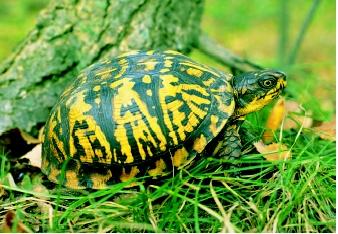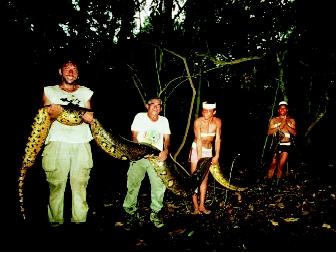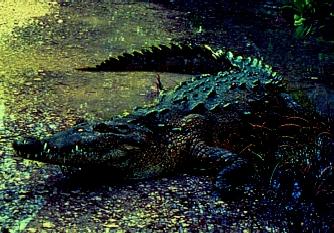Reptiles
Four reptile groups have species found in aquatic habitats: turtles, lizards, snakes, and crocodilians. Although most must return to land to nest, many have adapted to spend the majority of their lives in water.
Turtles
Turtles are the oldest living reptiles, having evolved before the dinosaurs, more than 200 million years ago. Of the more than 250 turtle species, about 75 percent utilize aquatic habitats. Found on all continents except Antarctica, these habitats include lakes, bogs, rivers, swamps, estuaries, mangroves, and the open ocean.

Turtle sizes range from the bog turtle, at under 10 centimeters (4 inches) to the leatherback sea turtle, which can reach more than 2 meters (6.5 feet) in length. Some turtle species may live up to 100 years or longer, but most probably live less than half that. All species lay eggs to reproduce and show no parental care.
Turtle shells have two parts, the upper carapace and lower plastron, made up of many separate bones. Hard scale-like scutes usually grow over this bony shell. The soft-shelled turtles have a reduced bony layer in their shell and do not grow scutes, instead covering the shell with leathery skin.
The turtle shell is part of the skeleton with the rib bones fused to the interior portion, so turtles cannot leave their shells. Excluding the sea turtles, most species are able to retract their head and limbs into the shell for protection. Some, like the box turtles, have developed hinges to close off the outside entirely when threatened.
Fresh-water turtles are opportunistic feeders, eating a variety of animals and plants. Fish, snails, frogs, worms, and insects are common prey . Some species actively hunt prey within the water, whereas others rely on surprise attacks. The alligator snapping turtle has a fleshy lure that it moves to attract fish directly into its mouth.
Many fresh-water turtle species throughout the world are endangered , because they are hunted for food, medicine, their shells, and the pet trade. The number of endangered turtles is also increasing because of a loss of wetland habitats owing to human development.
The seven species of sea turtles have fully adapted to an aquatic lifestyle, spending their entire lives in the ocean except for nesting. Their major adaptation to this aquatic existence is strong, paddle-like front flippers that enable the turtle to "fly" through the water. Strong swimmers, sea turtles may migrate great distances between feeding and nesting areas in tropical and subtropical oceans.
Female sea turtles return to beaches in the region of their birth to lay their nests. The turtle digs an egg chamber using her hind flippers, deposits 60 to 160 eggs in the nest, and leaves it to incubate. Females nest several times during one season before returning to their feeding grounds. Most species nest every 2 to 3 years.
Hatchlings dig their way out of the nest and generally emerge at night. To find the water, they orient themselves to the brightest horizon, which traditionally occurred over the open ocean. Unfortunately, coastal development has resulted in artificial lights, leading many hatchlings inland, where they face predation and desiccation (drying out).
All sea turtle species are considered threatened or endangered. For decades, harvesting of eggs and nesting sea turtles significantly reduced populations until protective measures began in the 1970s and 1980s. Continued coastal development along nesting beaches and entanglement in fishing gear are considered the greatest threats to their survival.
Lizards
Marine iguanas are found along the coast and intertidal waters of the Galapagos Islands. The only marine lizard in the world, it feeds almost exclusively

The lizards may reach 1.5 meters (5 feet) in length, with almost half that being tail. Salt glands between their eyes excrete excess salt into the nose, where the animal "sneezes" it out of the body. While very few natural predators exist, introduced species such as rats, cats, and dogs are a threat to populations on some of the islands. These animals eat the marine iguana's eggs, which are buried in inland nests.
A few other lizard species are associated with fresh water. The water monitor lizards are found along waterways in forested parts of Asia and Indonesia. They feed on a wide variety of aquatic and terrestrial prey. Similarly, the Chinese crocodile lizard, water dragon lizards, and a few skink species also are known to utilize aquatic habitats to escape predators or find food.
Snakes
Approximately 70 species of sea snakes exist, primarily in the tropical waters of the Pacific and Indian Oceans. Many are found in shallow waters near coral reefs, mangroves, and estuaries. *
Possessing highly toxic venom, most sea snakes hunt fish along the ocean bottom, exploring crevices in rocks or coral reefs. The venom contains neurotoxins, which disrupt signals from the nerves to the muscles, paralyzing prey. The beaked sea snake, responsible for many human deaths, maintains enough venom to kill more than 50 people. Although almost all sea snakes are potentially lethal to humans, most do not bite nonprey unless provoked.
While similar to the terrestrial snakes from which they evolved, sea snakes have adapted to aquatic habitats. They have a flattened, paddle-like

Other snake species are found in fresh-water habitats throughout the world. This group includes the largest snake in the world, the giant anaconda. Residing in South America, this snake reaches lengths of 9 meters (30 feet) and can weigh 225 kilograms (500 pounds). This giant predator feeds on turtles, fish, large rodents, deer, tapir, and birds. Although rare, attacks on humans have occurred.
Other than the cottonmouth, the majority of fresh-water snakes in the United States are nonvenomous. Examples include the northern, banded, brown, and green water snakes.
Crocodilians
The 23 species of crocodilians include alligators, caimans, crocodiles, and the gharial. They are found in 91 countries around the world, congregated in tropic and subtropic areas. Salt-water crocodiles are the largest living reptiles in the world, with one confirmed at 6.3 meters (20.7 feet) long. Cuvier's dwarf caiman, which reaches only 1.5 meters (5 feet) in length, is the smallest species.
An important aquatic adaptation of crocodilians is a valve that seals off the throat when the animal submerges to prevent water from entering the stomach and lungs. This is utilized in capturing prey underwater or drowning terrestrial (land-based) prey. Internally, the nostrils enter the airway behind this valve, allowing the crocodilians to remain submerged except for their eyes and nostrils.
Another adaptation consists of special sensory cells in the skin, particularly around the head, that are believed to sense pressure changes. These cells likely assist in locating prey in the dark and murky waters in which crocodilians live.
Crocodilians are carnivorous , opportunistic feeders. The majority of species feed primarily on fish, amphibians, turtles, and small birds and animals. Alligator jaws are powerful enough to bite open the shell of turtles or snap limbs of larger mammals.
All the crocodilians reproduce by laying eggs, generally one nest per year. The American alligator builds elaborate mounds of mud and decaying plant materials that incubate the eggs. After nesting, the female remains nearby, protecting the eggs from predators. At the end of the 2-month incubation, the hatchlings call to the mother for assistance in getting out of the nest. The mother picks up the hatchlings and carries them to the water. She provides protection for the hatchlings for up to a year.
SEE ALSO Endangered Species Act ; Life in Water .
Andrew P. Diller
Bibliography
Alderton, David. Turtles and Tortoises of the World. New York: Facts on File, 1988.
Grenard, Steve. Handbook of Alligators and Crocodiles. Malabar, FL: Krieger Publishing, 1991.
Heatwole, Harold. Sea Snakes, 2nd ed. Malabar, FL: Krieger Publishing, 1999.
Lutz, Peter L., and John A. Musick, eds. The Biology of Sea Turtles. Boca Raton, FL:CRC Press, 1997.
Mattison, Christopher. Lizards of the World. New York: Facts on File, 1989.
HATCHING TURTLES
The Kemp's ridley is the most endangered sea turtle because of overharvesting of eggs at its one nesting beach in Tamaulipas, Mexico. To establish a second nesting location, biologists are relocating eggs to South Padre Island, Texas.
During incubation, the sex of hatchlings is determined by temperature. Cooler temperatures within the nest produce male hatchlings, whereas warmer temperatures produce females.
A majority of female hatchlings are produced at most nesting beaches because of their tropical locations. On emerging from the nest, hatchlings are raised in tanks until they are large enough to avoid most predators, and then are released. After maturing in the wild, these female turtles return to Texas to nest.
* See "Life in Water" for a photograph of a sea snake.
Comment about this article, ask questions, or add new information about this topic: